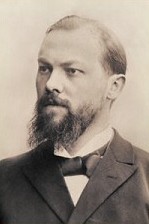Loading AI tools
German theologian (1866–1937) From Wikipedia, the free encyclopedia
Gustav Adolf Deissmann (7 November 1866 – 5 April 1937) was a German Protestant theologian, best known for his leading work on the Greek language used in the New Testament, which he showed was the koine, or commonly used tongue of the Hellenistic world of that time.[1]
Gustav Adolf Deissmann | |
|---|---|
 | |
| Born | 7 November 1866 |
| Died | 5 April 1937 (aged 70) |
| Nationality | German |
| Other names | Deißmann |
| Occupation | theologian |
| Known for | work on the Greek language used in the New Testament |
| Academic work | |
| Institutions | University of Heidelberg, University of Berlin |
Deissmann was professor of theology at the Ruprecht Karl University of Heidelberg (1897–1908), and then at the Friedrich Wilhelms University of Berlin (1908–1935). He was twice nominated for the Nobel Peace Prize, and held eight honorary doctorates from 6 different countries.[2]
In 1904 he founded, together with Albrecht Dieterich, the Eranos circle in Heidelberg. Members included Ernst Troeltsch, Max Weber, Eberhard Gothein, Georg Jellinek, Karl Rathgen, and Wilhelm Windelband.[3]
In Berlin, Deissmann's academic focus began to shift from Greek philology to the ecumenical movement, church reform and, significantly, international Völkerverständigung (i.e. peace-promoting mutual understanding between nations and cultures). From 1914 until 1922 he produced a regular semi-political international communiqué, the Evangelischer Wochenbrief (1914–1921), with its English equivalent Protestant Weekly Letters (1914–1917). Its target audience was primarily influential German and American Christians, and it provided a forum for the advancement of peace and understanding among nations.[4]
In 1925 Deissmann became aware of the disintegration of ancient Ephesus, a historically important archaeological site, partly excavated before World War I under the auspices of the Austrian Archaeological Institute. Deissmann campaigned single-handedly for several years, both on a national and international level, to raise awareness of the plight of Ephesus, and managed to organise funding for the archaeological work to recommence in 1926, and continued annually until 1929.[5]
Deissmann died on 5 April 1937, in Wünsdorf near Berlin, where he is buried in the local cemetery.
{{cite book}}: CS1 maint: location missing publisher (link){{cite book}}: CS1 maint: location missing publisher (link){{cite book}}: CS1 maint: location missing publisher (link){{cite book}}: CS1 maint: location missing publisher (link){{cite book}}: CS1 maint: location missing publisher (link){{cite book}}: CS1 maint: location missing publisher (link){{cite book}}: CS1 maint: location missing publisher (link){{cite book}}: CS1 maint: location missing publisher (link){{cite book}}: CS1 maint: location missing publisher (link){{cite book}}: CS1 maint: location missing publisher (link)Seamless Wikipedia browsing. On steroids.
Every time you click a link to Wikipedia, Wiktionary or Wikiquote in your browser's search results, it will show the modern Wikiwand interface.
Wikiwand extension is a five stars, simple, with minimum permission required to keep your browsing private, safe and transparent.